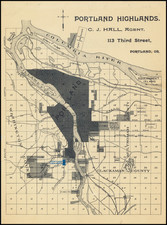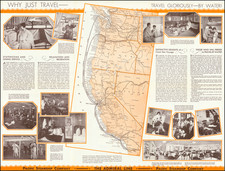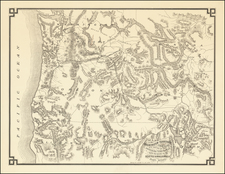Rare birdseye view of Portland, Oregon, drawn by Pierce & Elliott and published by Elliott in San Francisco.
The view as created to promote Holladay's Addition, with lots for sale by the Oregon Real Estate Company. Portland is shown in the distance, across the Willamette River. Holladay's Addition is in the city of East Portland, which extends to the left on this map. The city of Albina is shown on the right. The map illustrates the development of transportation infrastructure by 1890. Railroad lines are labeled on the map; one line is shown running through Sullivan's Gulch. The Steel, Morrison and Madison Street bridges cross the Willamette River; all three bridges were subsequently replaced, and the Madison Street Bridge was renamed after Hawthorne Blvd. Several streetcar lines are shown on the map, including a few that run through Holladay's Addition. Street names are noted on the map, though some streets have since been renamed.
A list at the bottom identifies 32 points of interest.
This is one of three views of Portland published by Elliott in 1890, including:
- Portland, Oregon; and Surroundings. 1890. Looking North: https://digitalcollections.ohs.org/portland-oregon-and-surroundings-1890-looking-north
- Portland, Oregon, 1890 (B.W. Pierce, Clohessy & Strengele) https://calisphere.org/item/ark:/13030/tf3n39p1qp/
- Portland, Oregon. Looking West, Showing Holladay's Addition in the Foreground. . .1890
Portland, Oregon
By 1890, Portland, Oregon, was a thriving city or about 46,000, driven by its strategic location at the convergence of the river and the Columbia River, which made it a hub for trade and commerce. population. The downtown area was compact and densely populated, with rows of brick buildings and wooden houses.
One of the most prominent features of Portland in 1890 was its network of waterways. The Willamette and Columbia Rivers were alive with steamboats, sailboats, and other vessels, moving goods and people up and down the rivers. The city's waterfront was a hub of activity, with warehouses, shipyards, and docks lining the banks of the rivers. Some of the major wharfs and bridges in Portland included the Burnside Bridge, the Morrison Bridge, and the Steel Bridge. The city was also home to several shipping companies, such as the Oregon Steam Navigation Company and the Union Pacific Railroad.
In addition to its waterways, Portland was also home to a growing rail network. The city was served by several railroads, including the Oregon & California Railroad, the Northern Pacific Railroad, and the Portland & Western Railroad. These railroads transported goods and people to and from the city, and also connected Portland to other cities in the region, making it an important hub for trade and commerce.
At the time, the street car system in Portland was operated by the Portland Street Railway Company (established in 1872 with horse drawn car service), the Willamette Bridge Railway Company and the Portland Cable Railway. These companies operated a network of tracks that ran through the city, connecting the downtown area with outlying neighborhoods and suburbs. By 1890, the street cars were being powered by electricity, which was supplied by the Portland General Electric Company.
Rarity
The view was unknown to Reps and is not listed in OCLC.
We note examples in the Multnomah County Library and Portland Archives.









![(Texas and California) The Whig Almanac and United States Register for 1843 [bound with:] The Whig Almanac and Politicians' Register for 1845 [bound with:] The Whig Almanac, and Politicians' Register for 1846 [with maps of Texas and Oregon] [bound with:] The Whig Almanac: 1847.](https://storage.googleapis.com/raremaps/img/small/87041.jpg)


![[ Pacific Northwest - Northwest Passage ] Limes Occidentis Quivira et Anian. 1597](https://storage.googleapis.com/raremaps/img/small/71207.jpg)
![[ Rare Early State! ] America's Greatest Scenic Asset The Columbia River Highway [cover title:] Portland Oregon featuring the Columbia River Highway](https://storage.googleapis.com/raremaps/img/small/77120.jpg)
